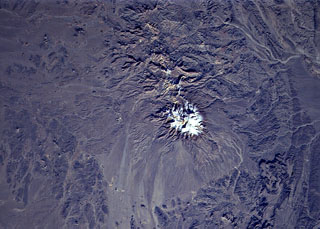Report on Taftan (Iran) — October 1999
Bulletin of the Global Volcanism Network, vol. 24, no. 10 (October 1999)
Managing Editor: Richard Wunderman.
Taftan (Iran) Visitors note mineral springs and fumaroles
Please cite this report as:
Global Volcanism Program, 1999. Report on Taftan (Iran) (Wunderman, R., ed.). Bulletin of the Global Volcanism Network, 24:10. Smithsonian Institution. https://doi.org/10.5479/si.GVP.BGVN199910-232050
Taftan
Iran
28.6°N, 61.13°E; summit elev. 3940 m
All times are local (unless otherwise noted)
In response to reported fumarolic activity near the summit, a group from the Societe de Volcanologie Geneve ascended the summit on 27 July 1999. The activity focused at a solfatara 1.5 x 5 m in size with several openings emitting SO2-rich vapor plumes. The surrounding area resembled a snowcap despite consisting entirely of sulfur and clay.
During the ascent clear water was seen at 3,220 m elevation almost 800 m below the summit. At about the 3,240 m elevation, a spring was discovered pouring from the flank of the volcano. The water in the spring reached a temperature of nearly 30°C and a pH of 1. The spring water created a white-yellowish deposit which darkened as it dried. The dried deposits were colored sharp yellow to dark orange. Despite their color, these deposits were not formed from sulfur, but rather from iron chlorides. When redissolved back in water, a colorless solution resulted.
Geological Summary. Taftan is a strongly eroded andesitic stratovolcano with two prominent summits. The volcano was constructed along the Makran-Chagai Arc in SE Iran. The higher SE summit cone has been the source of lava flows, as well as of highly active, sulfur-encrusted fumaroles. In January 1902 the volcano was reported to be smoking heavily for several days, with occasional strong night-time glow. A lava flow was reported in 1993, but may have been a mistaken observation of a molten sulfur flow. Despite these reports there is no clear evidence for Holocene activity. The youngest date obtained by Pang et al. (2014), using U-Pb on a zircon, was about 800 ka. Biabangard and Moradian (2008) obtained K-Ar dates around 700 ka.
Information Contacts: D. Zurcher and R. Haubrichs, Societe de Volcanologie Geneve (SVG), C.P. 6423, CH-1211, Geneve 6, Switzerland (Bulletin de la SVG, October 1999, p. 6 (in French)).

